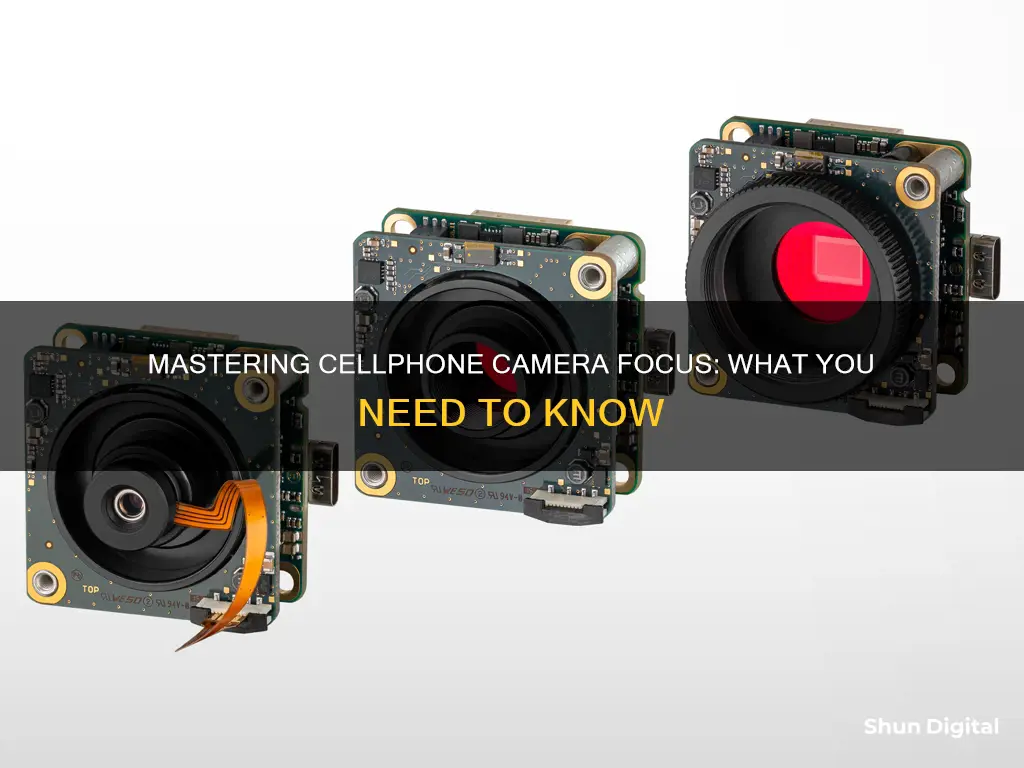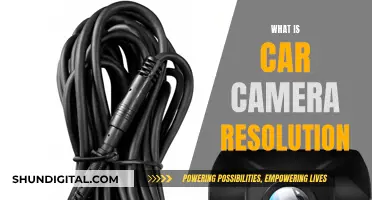
Smartphone cameras have improved significantly over time, and autofocus systems are now a standard feature. There are three main types of autofocus: contrast-detection autofocus, phase-detection autofocus, and laser autofocus. Contrast-detection autofocus is the most common method, where the camera measures the contrast in an image to determine if it is in focus. This system is slow and doesn't work well in low-light conditions. Phase-detection autofocus is faster and more accurate, and is used in high-end smartphones. It compares light from two apertures on opposite sides of the lens to determine if the image is in focus. Laser autofocus, used in some LG smartphones, is the fastest method and works by emitting a beam of infrared light to calculate the distance to the object.
| Characteristics | Values |
|---|---|
| Camera focus | Auto-focus (AF) |
| AF types | Active, passive, hybrid |
| Passive AF types | Contrast-detection auto-focus (CDAF), phase-detection autofocus (PDAF), dual-pixel auto-focus |
| Active AF types | Laser auto-focus |
| AF modes | AF-S (Auto-focus Single), AF-C (Continuous auto-focus) |
| AF process | Software and algorithm, mechanically adjusting the lens position |
| AF speed | ~1 second (CDAF), 0.3 seconds (PDAF), 0.276 seconds (laser AF) |
| AF accuracy | Depends on lighting conditions, distance, and movement |
| AF limitations | Requires additional hardware, slow, doesn't work in low-light conditions, can't track moving objects |
| Manual focus | Available in manual mode, adjusted using a slider in the camera app |
What You'll Learn

Contrast-detection auto-focus (CDAF)
A digital image is made up of pixels that correspond to photosites on a camera's image sensor. When an image is in focus, the pixels are clear and well-defined, with high contrast. Conversely, when an image is out of focus, the pixels are blurry and have low contrast.
The CDAF system uses this information to adjust the camera's lenses until the image is in focus. It does so by moving the focus motor back and forth, even past the focal point, in search of the highest contrast between pixels. This is a trial-and-error process, and as such, CDAF is slower than other autofocus systems.
CDAF is dependent on light and contrast, so it does not perform well in low-light conditions or when there is little contrast in the scene. It is also not ideal for capturing moving subjects, as the contrast information changes when there is movement in the scene.
Charging Camera Batteries: Using the DigiPower Charger
You may want to see also

Phase-detection auto-focus (PDAF)
Phase-detection autofocus (PDAF) is a faster form of autofocus than contrast-detection autofocus (CDAF). It relies more on software and algorithms than on mechanically adjusting the lens position.
With PDAF, a small number of pixels on a sensor are set aside and embedded with a phase-detection photodiode (a device on the image sensor that converts light into an electric current). These pixels are scattered across the sensor and receive light from opposite sides of the lens. This is similar to how humans receive light separately through the left and right eyes to create one image in the brain.
Using data from all the phase-detecting pixels spread across the sensor, the PDAF algorithm determines if the image is in focus. If the data of the light waves gathered from the photodiodes all match up, then the light profile is in phase, and the picture is in focus. If the light waves are not in phase, the image will not be in focus. The light information captured by the photodiodes is then used to determine the correct position of the lens to produce a sharp image.
After the calculations are made, the focus motor moves the lens to the right position for a crisp image. All of this happens in a fraction of a second, making the PDAF system much faster than CDAF. This speed makes it ideal for moving objects or action shots.
Like CDAF, phase-detection autofocus relies on light coming through the lens. If the scene is too dark, it may take longer for PDAF to analyse the scene and focus the image correctly.
Phase-detection autofocus in a continuously focusing mode (e.g. "AI Servo" for Canon, "AF-C" for Nikon, Pentax and Sony) is a closed-loop control process. In a focus-locking mode (e.g. "One-Shot" for Canon, "AF-S" for Nikon and Sony), the system is widely believed to be a "one measurement, one movement" open-loop control process. However, focus is only confirmed when the AF sensor sees an in-focus subject.
Auto-Focus Camera Tips for Self-Portrait Perfection
You may want to see also

Laser auto-focus
Since the speed at which the laser travels is constant, the distance can be determined by calculating the time it takes for the laser to reach the object and then bounce back to the sensor. This entire process is very quick, taking only about 0.276 seconds to get an image into focus.
Mastering Park Camera Mode: Understanding the Boxes
You may want to see also

Manual focus
To shoot in manual mode on a smartphone camera, you first need to understand the fundamentals of exposing an image in photography. You need to learn about ISO, shutter speed, aperture, and white balance.
ISO is a camera setting that will brighten or darken the photo because of higher light sensitivity. As you increase the ISO, your images will become progressively brighter. The lighter the scene, the lower the ISO number you need to take sharp, well-lit pictures.
Shutter speed is the length of time that the shutter of the camera is open. Opening the shutter will allow light to travel to the camera sensor. It is the amount of time the camera takes to make the image. A slower shutter speed is preferable if you are in a low-light environment, but if the shutter speed is too slow, you might experience motion blur.
The aperture is the hole through which light reaches the sensor. It can be made bigger or smaller by changing the f-stop. The aperture controls how wide or narrow this hole is. A wider aperture will allow more light in and increase exposure. It will also decrease the depth of field and make the background/foreground blurrier.
White balance is a prevalent setting you’ll probably find included even in basic camera and editing apps. This setting adjusts the color that represents white light, thereby shifting all of the other colors too. This allows for the creative use of warmer and cooler shots.
To find the manual camera mode for your mobile phone, go to the stock Android camera app and find the mode called "manual" or "professional". You might find it between slow mode, time-lapse, or panorama settings, or at the bottom of your screen.
To manually focus on a camera app, you can often use your finger to select the subject you want in focus. Or you can hold down the shutter button as the app takes you through the focus range, and then pull your finger away when your subject is in focus.
Are Speeding Tickets from Cameras in DC Enforceable?
You may want to see also

Active, passive, and hybrid autofocus
Autofocus (AF) systems use a combination of sensors, control systems, and motors to focus on a selected point or area. They can be distinguished as active, passive, or hybrid types.
Passive Autofocus
Passive autofocus (AF) calculates and adjusts the camera's focus without the need for additional specialised hardware. It relies on light and the contrast in the scene to ascertain focus. It is a non-intrusive method that does not direct any energy, such as infrared light or ultrasonic sound waves, towards the subject.
Passive AF can be achieved through phase detection or contrast measurement. Phase detection is often used in film and digital SLR cameras. It involves dividing the incoming light into pairs of images and comparing them to determine the correct focus. Contrast measurement, on the other hand, measures the contrast within a sensor field through the lens, adjusting the optical system until maximal contrast is detected.
Passive AF has some downsides. It may not work well in low-light conditions or when there is little contrast in the scene, such as a blue sky or white wall. It also struggles when trying to focus on reflective surfaces or objects at a distance. Additionally, it is generally slower than active AF.
Active Autofocus
Active AF measures the distance to the subject independently of the optical system and then adjusts the focus accordingly. It often uses infrared light or ultrasonic sound waves to determine the distance. Infrared light is usually used to triangulate the distance to the subject, while ultrasonic sound waves measure the delay in their reflection to calculate the distance.
Active AF has its own set of limitations. It may not work through windows or other transparent obstacles, as the infrared light or sound waves can be reflected by the glass. It may also struggle with very close-up subjects, such as in macro photography. Additionally, active AF systems are often less accurate and more expensive due to the need for additional hardware.
Hybrid Autofocus
Hybrid AF combines two or more autofocus methods, such as active and passive AF, or phase detection and contrast measurement, to compensate for the weaknesses of individual methods and increase overall reliability, accuracy, and speed.
For example, a passive phase-detection AF system can be combined with an active IR or ultrasonic AF system. The passive system provides more accuracy, while the active system works regardless of lighting conditions. Another combination is passive phase-detection AF with passive contrast AF, sometimes assisted by active methods. Phase-detection AF is fast but struggles in low-light conditions, while contrast AF is slower but can work in low-light conditions. By combining these methods, the autofocus system gains the benefits of both.
Flying with Camera Gear: Safely Transporting Lithium-Ion Batteries
You may want to see also
Frequently asked questions
You can access the manual focus feature by going to the Manual Mode (or ‘professional’ mode) of your camera app. A slider will appear on the screen that allows you to shift focus as you please.
There are three types of auto-focus: contrast-detection auto-focus, phase-detection auto-focus, and laser auto-focus. Contrast-detection auto-focus is the most common and works by moving the lens back and forth until the position of maximum focus is found. Phase-detection auto-focus is faster and more advanced, and it works by analysing the light as it passes through the lens and comparing light from two apertures on opposite sides of the lens. Laser auto-focus is the fastest and works by emitting a beam of infrared light and calculating the time for the light to be reflected back.
The pros of auto-focus are that it can be fast and accurate, and it can also be used to track moving objects. The cons are that it doesn't always work in low-light conditions and can be confused by reflections.







